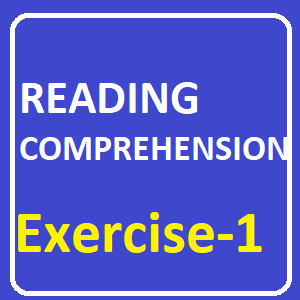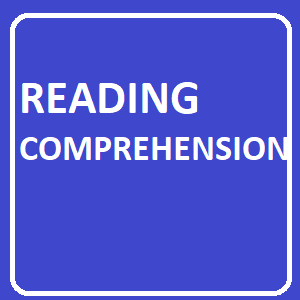Reading Comprehension Exercise-1
#1. The word “altered” in line 16 is closest in meaning to
B ) This is a vocabulary question. One can look at the discussion in the paragraph about increasing and decreasing salinity for clues to the meaning of “altered.”
#2. The author groups North American Indians according to their
A ) This is an organization and logic question. The author organizes the information in the passage by the names of various groups and where they lived, but does not refer to any of the things mentioned in the other options Reading Comprehension
#3. It can be inferred from the passage that the dwellings of the Hopi and Zuni were
B ) This is an inference question. Because the passage states that the buildings were “like modern apartment houses” and that “some were four stories high,” it can be inferred that the dwellings were highly advanced.
#4. According to the passage, the Hopi and Zuni typically built their homes
D ) This is a factual information question. Lines 4–5 of the passage state that “These buildings were usually put up against cliffs.”
#5. The word “this” in line 5 refers to
B ) This is a referential relationship question. The lines preceding line 5 talk about the process of evaporation; “this” refers to evaporation
#6. Why does the author mention the Weddell Sea?
C ) This is an organization and logic question. The fourth paragraph talks about the formation of sea ice and the following paragraph, which mentions Weddell Sea, is there to give a concrete example of that formation
#7. The word “it” in line 19 refers to
C ) This is a referential relationship question. In lines 18–19, the passage states that “seawater . . . has a higher salinity than it did before the ice appeared.” “It” refers to seawater
#8. The word “They” in line 6 refers to
B ) This is a referential relationship question. The pronoun “They” refers to buildings. Although the other choices are also plural nouns, “buildings” is the logical referent for “they.”
#9. Which of the following statements about the salinity of a body of water can best be inferred from the passage?
D ) This is an inference question. The other three options are not supported by the passage, but the passage does discuss a number of factors that affect ocean salinity
#10. According to the passage, which of the following groups lived in the grasslands?
B ) This is a factual information question. The information answering the question is stated in lines 19–20 of the passage.
#11. What does the passage mainly discuss?
D ) This is a main idea question. Although architecture, movement, ceremonies, and rituals are mentioned in the passage, D ) best summarizes the general topic of the entire passage.
#12. Which of the following is NOT mentioned by the author as a dwelling place of early North Americans?
A ) This is a factual information question. NOTE: By using the word “NOT,” the question asks the reader to remember which of the choices were mentioned and to recognize which choice was not or to review the passage to be sure. The correct answer is the choice that is NOT mentioned—in this case, log cabins
#13. Which of the following is NOT a result of the formation of ocean ice?
C ) This is another factual information question. It is asking for the piece of information that is NOT true. Lines 17–19 state that seawater under ice has a higher salinity, so C ) cannot be true
#14. The author uses the phrase “the three sisters” in line 8 to refer to
C ) This is a referential relationship question. Corn, beans, and squash are important crops that are mentioned just after the phrase “the three sisters.”
#15. According to the passage, the ocean generally has more salt in
B ) This is a factual information question. The passage states in the third paragraph that ocean salinity is higher in tropical regions.
#16. What does the passage mainly discuss?
D ) This is a main idea question. The passage discusses the processes by which ocean salinity is increased or decreased
#17. The word “scarce” in line 10 is closest in meaning to
A ) This is a vocabulary question. Clues to the meaning of this word are in the phrases “dry country” (line 10) and “brought water . . . through irrigation ditches”
#18. All of the following are processes that decrease salinity EXCEPT
A ) This is a factual information question. Note that the presence of the word “EXCEPT” in the question means you must find the one answer that is not true. Evaporation increases rather than decreases salinity.
#19. Which of the following animals was most important to the Plains Indians?
D ) This is a factual information question. The passage states in lines 20–21 that the bison was the chief source of food, clothing, and tent covering. “Chief” means “most important” in this context.
#20. Which of the following is true of the Shoshone and Ute?
A ) This is a factual information question. The first paragraph suggests that the Hopi and Zuni lived in permanent homes in villages. In lines 13–14, the Shoshone and Ute are described as less-settled groups
#21. What can be inferred about the water near the bottom of oceans?
B ) This is an inference question. The final paragraph discusses seawater with a high salinity. The last sentence states that “This heavy water . . . is found in the deeper portions of the oceans of the world.” This information supports B ) .
Results
-
HD Quiz powered by harmonic design
Reading Comprehension Exercise-1

 |
 |


